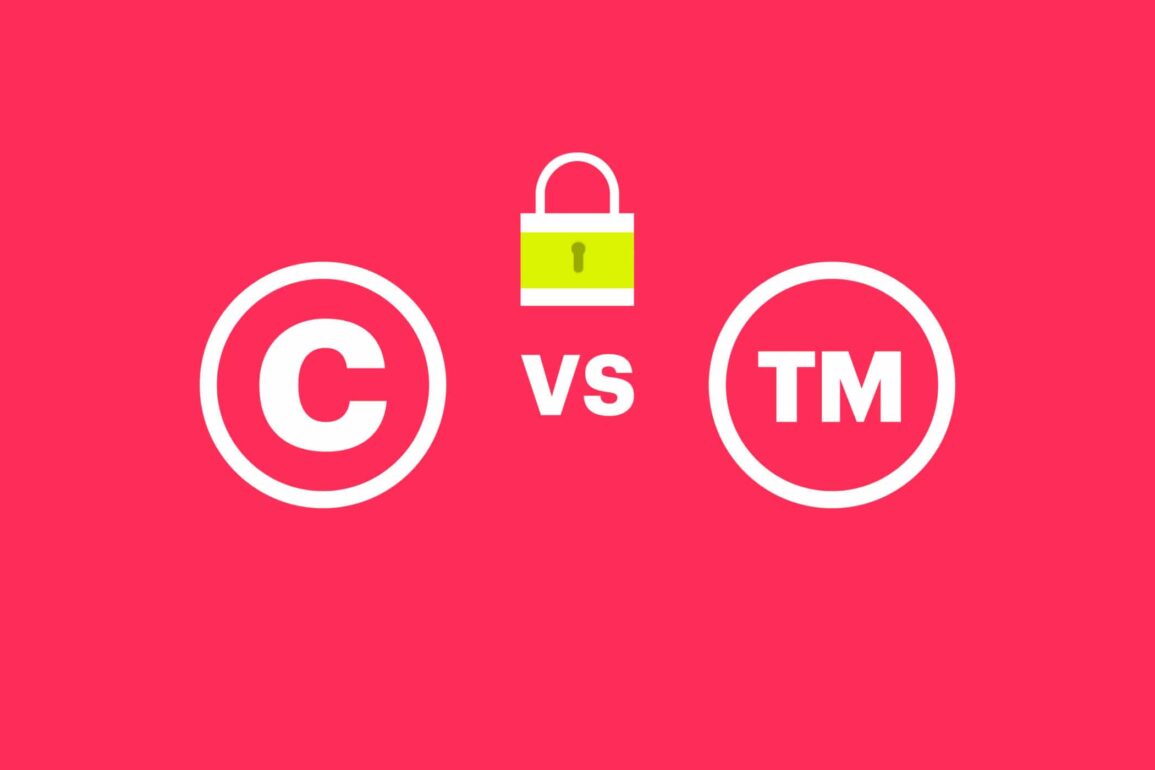Copyright vs trademark: How to protect your logo

There’s more to your business than a unique service or product.
Customers identify you and your organization based on a number of unique characteristics. They look not only at your personality and tone of voice online, but also you distinct image in the marketplace.
While many things can contribute to a company’s aesthetic, from its website design, to signage and carefully created marketing campaigns, the most valuable visual asset you have is your logo.
Before your customers have a chance to learn more about your business and what it stands for by reading your product descriptions or assessing your website, they often make judgements based on your logo.
After all, your logo is plastered onto everything you own, from your product packaging to your email newsletters.
Used correctly, a logo can share valuable information about your business with your audience. It can tell your customers what kind of company you run, what values you hold close, and more. Logos can even cultivate brand loyalty, and 43% of customers spend extra on brands they feel loyal to.
Like the other components of your brand identity, your logo makes up part of the valuable DNA that sets your venture apart from the crowd. By using a logo copyright or trademark, you can ensure that you have the protection in place that you need to defend your logo and your brand.
The question is, what is the difference between a copyright and a trademark?
More importantly, how do you know which solution is most important to your organization’s growth?
Let’s find out.

Trademark vs. copyright: The basics
Whether you opt for a logo copyright or trademark to protect your business, you’re defending your intellectual property. Both trademarks and copyrights are designed to give you more rights when it comes to preventing other people from using your brand assets.
One thing worth noting if you’re building your business in the US is that you don’t have to register a copyright or trademark your company logo. That’s because as soon as you design your logo, you’ll automatically have ownership over that content.
The US gives copyright ownership to the original creator of any work.
Additionally, you can gain ownership over a logo that someone else designed for you too. All you need to do is buy the logo and have it transferred to you. Easy peasy.
However, taking the additional step of registering your copyright or implementing a trademark can give you access to some critical protection. Registering a trademark, for instance, will protect you from losing your rights to that content if someone else tries to use a very similar design.
By registering for copyright and trademark protection, you declare your exclusive rights to use that design. That means that you have a unique aesthetic that you can continue to use to build your brand personality and gain traction in your marketplace.
When you copyright or trademark a logo, you tell the government that something belongs to you. However, the kind of defense you get with both solutions can differ.
For instance, a trademark protects artworks and ideas. On the other hand, copyrights are generally intended for creative intellectual design.
If that sounds a little confusing, don’t worry.
Let’s take a closer look at the difference between a logo copyright and trademark.
Copyright vs. trademark: What is a copyright?
So, what exactly is a copyright?
Copyrights were originally designed to protect the ownership that people have over their artistic works. This means that you can use them to defend your literary, artistic, musical, and even theatrical creations.
For example, if you shot a video for YouTube, you would be able to copyright it.
Unfortunately, basic ideas can’t be copyrighted. The concept that you want to claim ownership of needs to be tangible. You can’t just tell people that you own the “idea” of a logo.
Additionally, to access a logo copyright, your design would need to be 100% original.
Since a lot of logos are based on shapes and patterns that already exist, it’s very difficult to demand a copyright for your logo that will hold up in court.
On the plus side, if you do successfully apply for a copyright on your logo, that protection will last for an entire lifetime. In addition, some protections can continue to persist up to 70 years after your death.
What’s more, infringement of a copyright will give you the right to take anyone who tries to steal your design to court.
When you’re awarded your copyright, you get exclusive rights like:
- The ability to reproduce your logo.
- The right to distribute your logo wherever you choose.
- The right to allow other people to use your design.
Notably, although you automatically get copyright protection in the US from the moment an artwork is created – you only get certain benefits if you register that copyright.
You need to tell the government that you’re actually claiming the logo for yourself before they’ll let you take matters of infringement to court, for instance.
Copyright vs. trademark: What is a trademark?
So, then, what’s a trademark?
Well, it’s another form of intellectual property protection that’s similar in a lot of ways to copyright.
When it comes to deciding whether to copyright or trademark a logo, it’s worth noting that trademarks are designed to protect assets that differentiate you from other people or companies.
Businesses can use trademarks to claim certain names, words, symbols, and designs. You can even trademark your brand slogan if you want to.
Usually, when companies are looking for a reliable way to stop other people from using assets like logos, they stick with trademarks. It’s much easier to get a trademark for a logo than it is to apply for successful copyright.
The chances are that you’ve already seen the “TM” symbol on dozens of popular logos around the world.
The rights of a trademark will allow you and your business to protect your intellectual property (e.g., logo) from use by another business or individual. You can also use trademark law to stop people from using something very similar to your logo.
Anything close enough that your customers might get confused can be taken to court under trademark law.
Like with copyrights, trademarks don’t necessarily have to be registered. The owner of a trademark can establish something called “common law” rights on a mark. In the commerce world, this means that you can still stop other people from using your logo if you haven’t registered it.
However, taking the additional step to register your trademark can also offer useful benefits, like extra protection, just in case anyone does try to take your brand identity.

What is the difference between a copyright and trademark?
Hopefully, the definitions of copyright and trademark law above will have helped you to understand a little more about the differences between each form of protection.
While a trademark is something that differentiates and distinguishes your brand in a specific market, a copyright protects an original work from being reproduced. Filing a trademark application with the US trademark office allows you to stop other people from mimicking your brand identity.
Think of Disney, Apple, or Coke, for instance. All of these companies have trademark protection of their logos, names, slogans, and taglines. These individual assets all help the brands to convey important information about themselves to their audience.
Since trademarks are most commonly used to distinguish and identify a brand, it makes the most sense to file for trademarks when you want to defend your logo.
You can use your trademark to prevent other people from not only using your logo but creating something too similar to your original design.
However, there may still be reasons to apply for copyright protection on a logo too.
Copyrights generally protect things like pictures, songs, and even pieces of software code. They show the government of your country that you were the first person to produce a specific design and that you should be the only one to reproduce it.

Do you trademark or copyright a logo?
So, do you trademark or copyright a logo?
While most people would argue that logos fall more under trademark law than copyright law, there is some confusion in this space. A lot of professionally-designed logos would simultaneously qualify for both logo copyright and trademark.
For instance, if your logo qualifies as an original piece of artwork, and it’s also used to identify your company, then you can apply for copyright protection and trademark at the same time.
On the other hand, if you’re using pre-existing images and shapes in your logo, but you still want to prevent confusion by stopping other people from mimicking your design, then you need a trademark.
Notably, trademarks are easier to access for logo purposes than copyrights. Although everyone who designs a logo in the US will have some form of copyright protection, it’s hard to register for copyright and prove that your artwork is 100% original.
Let’s say you’re a bakery company and you try to copyright a standard image of a cake, then you would have to prove that your image is an original artwork. That’s often easier said than done.
Claiming a trademark gives you a wider scope of protection and support. Although you still need a certain level of creativity.
For instance, Wrigleys, the gum manufacturers, tried to trademark the name “Doublemint” for its chewing gum, but was unable to do so because the name was deemed “not creative enough.”
On the plus side, logo trademark will prevent other people from attempting to reproduce your logo or use something that is similar to your design.
However, trademarks cover a limited scope of situations, whereas copyright covers any instance of copying that affects the original creator’s business. It’s common for larger companies to avoid issues by claiming both logo copyright and trademark at the same time.
Tips for when you copyright or trademark a logo
The good news for those considering the copyright vs. trademark debate is that whatever route you decide to take, the process is usually very simple. You can go to the online registration website when applying for logo copyright and fill out the form there.
If your business is located in the United States, here’s where you can find your application form.
You don’t necessarily have to file over the web either. You can choose to apply in paper form using snail mail.
It’s worth noting. However, that filing for your application in paper form will usually take a lot longer. While it can take around 8 months for an electronic application to be processed, you’ll be waiting anywhere up to 13 months for a paper application to be returned to you.
If you choose the more convenient option of filing online, click on the eCO online registration option on the US Copyright office. Remember, you’ll need to enter some personal information at this stage, including the name of your business.
If someone else designed your company logo for you, then you’ll need to enter the name of the creator and the name of the owner separately. For the copyright of a logo, it’s also essential to include a high-res graphic representation of your logo.
If the design that you send to the US copyright office isn’t clear enough, then you could end up wasting a lot of time, as the office will need to request a better picture before they can proceed with your application. You’ll also have a small registration fee to pay.
After you’ve received confirmation about your copyright registration, and you know that you successfully have copyright protection, you can decide what to do next. Note that your copyright protection will be in place from the date that you apply.
Before you trademark your logo, you’ll need to do some due diligence. We recommend conducting a trademark search to ensure that no-one is already using a similar design in your area. You can do this by using the US Trademark Electronic Search System, or TESS.
Once you know for certain that your logo is unique and that you’re not going to be stepping on anyone’s toes with your application, you can file through the TEAS.
The trademark electronic application system will give you a form to fill out, similar to the copyright application outlined above. Once again, you’ll need to include your personal details, the details of your company, and information about the kind of trademark protection that you need.

Protecting your brand with a logo copyright or trademark
One particularly important thing to keep in mind once you’ve decided whether to copyright or trademark a logo for your brand, is that you’re responsible for enforcing your own trademark or copyright.
That means that you need to be willing to complain, or even take an infringement issue to court if you want to defend yourself against unauthorized use of your design.
The Trademark and Patent office of the United States can ensure that nobody will be able to register for the same logo mark as you. It’s also possible for the trademark office to prevent people from applying to own a similar design to yours.
However, you’re the person who needs to make sure that no other company tries to use your logo without permission.
Usually, the first step will involve sending a cease and desist letter to the person trying to use your design. Alternatively, you can hire an attorney to address the matter for you in court.
There are even companies that can help you to watch out for people potentially using your protected designs. “Trademark watch” services ensure that nobody else tries to use your mark, although these services are usually reserved for bigger brands.
Remember, although both copyright and trademarks can help with protecting your intellectual property, each option offers a very different level of protection and supports various kinds of assets.
While copyrights protect artistic works, trademarks are more focused on defending the assets that define and identify your brand.
In a world where your logo can make a massive difference to how people feel about your brand, it’s essential to ensure that you have the right protection for your visual assets. Your logo isn’t just another component in your company’s roster of marketing and sales tools.
This intellectual property helps to distinguish you from the competition and remind customers why they love purchasing from you.
Make sure that you have the right copyright and trademark protection, so you don’t have to worry about losing customers due to brand confusion.
Want to learn more about creating unique brand marks, or protecting your logos from theft? Read through the other articles available here at Fabrik or consider contacting us today with help from everything from brand management, to logo design.
Fabrik Brands: A creative agency for our times.











